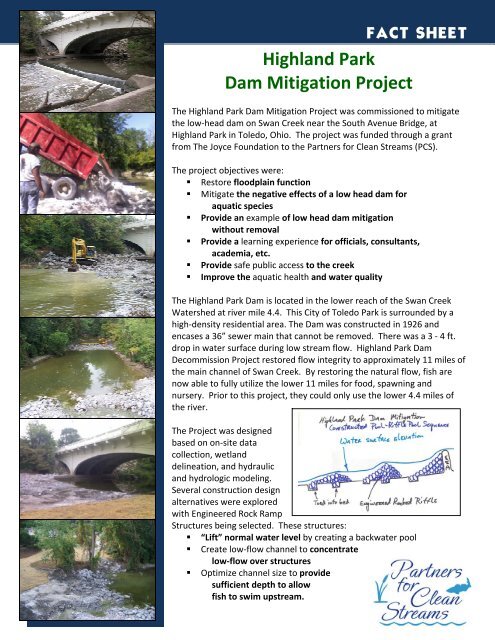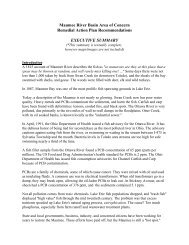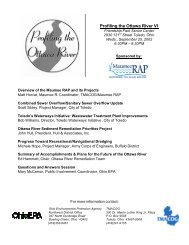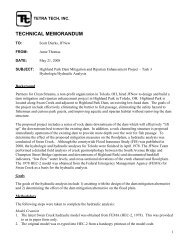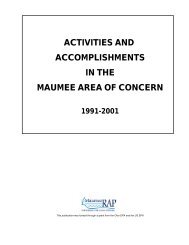Highland Park Dam Mitigation Project - Partners for Clean Streams
Highland Park Dam Mitigation Project - Partners for Clean Streams
Highland Park Dam Mitigation Project - Partners for Clean Streams
Create successful ePaper yourself
Turn your PDF publications into a flip-book with our unique Google optimized e-Paper software.
4/09<br />
FACT SHEET<br />
<strong>Highland</strong> <strong>Park</strong><br />
<strong>Dam</strong> <strong>Mitigation</strong> <strong>Project</strong><br />
The <strong>Highland</strong> <strong>Park</strong> <strong>Dam</strong> <strong>Mitigation</strong> <strong>Project</strong> was commissioned to mitigate<br />
the low‐head dam on Swan Creek near the South Avenue Bridge, at<br />
<strong>Highland</strong> <strong>Park</strong> in Toledo, Ohio. The project was funded through a grant<br />
from The Joyce Foundation to the <strong>Partners</strong> <strong>for</strong> <strong>Clean</strong> <strong>Streams</strong> (PCS).<br />
The project objectives were:<br />
� Restore floodplain function<br />
� Mitigate the negative effects of a low head dam <strong>for</strong><br />
aquatic species<br />
� Provide an example of low head dam mitigation<br />
without removal<br />
� Provide a learning experience <strong>for</strong> officials, consultants,<br />
academia, etc.<br />
� Provide safe public access to the creek<br />
� Improve the aquatic health and water quality<br />
The <strong>Highland</strong> <strong>Park</strong> <strong>Dam</strong> is located in the lower reach of the Swan Creek<br />
Watershed at river mile 4.4. This City of Toledo <strong>Park</strong> is surrounded by a<br />
high‐density residential area. The <strong>Dam</strong> was constructed in 1926 and<br />
encases a 36” sewer main that cannot be removed. There was a 3 ‐ 4 ft.<br />
drop in water surface during low stream flow. <strong>Highland</strong> <strong>Park</strong> <strong>Dam</strong><br />
Decommission <strong>Project</strong> restored flow integrity to approximately 11 miles of<br />
the main channel of Swan Creek. By restoring the natural flow, fish are<br />
now able to fully utilize the lower 11 miles <strong>for</strong> food, spawning and<br />
nursery. Prior to this project, they could only use the lower 4.4 miles of<br />
the river.<br />
The <strong>Project</strong> was designed<br />
based on on‐site data<br />
collection, wetland<br />
delineation, and hydraulic<br />
and hydrologic modeling.<br />
Several construction design<br />
alternatives were explored<br />
with Engineered Rock Ramp<br />
Structures being selected. These structures:<br />
� “Lift” normal water level by creating a backwater pool<br />
� Create low‐flow channel to concentrate<br />
low‐flow over structures<br />
� Optimize channel size to provide<br />
sufficient depth to allow<br />
fish to swim upstream.
4/09<br />
FACT SHEET<br />
Mussels were identified on‐site requiring permission from the Ohio Department of<br />
Natural Resources and US Fish and Wildlife Service be<strong>for</strong>e construction could start.<br />
<strong>Partners</strong> <strong>for</strong> <strong>Clean</strong> <strong>Streams</strong> hired a mussel expert to conduct an official survey,<br />
relocate any mussels found and conduct a follow‐up survivability survey in two<br />
years. Six species were found alive of which none were state or federally listed as<br />
threatened or endangered.<br />
Local plant materials were harvested with the<br />
assistance of the Toledo ZooTeens. On August<br />
12‐13, 2008, locally native species of willow and<br />
dogwood were harvested and then soaked to<br />
facilitate growth. The materials were installed throughout the construction<br />
along the streambank and along the keys <strong>for</strong> the engineered rock riffles.<br />
Rich Young and Mike Spyehalski said, “. . .<br />
white bass and walleye never used to come<br />
here and now they do but the only fish we<br />
have seen come over the dam are the white<br />
suckers. Now everything can make it."<br />
Actual construction began during the week of August 18, 2008 with<br />
site preparation. Six hundred tons of choke stone (3”‐4”average<br />
diameter) and 1900 tons of type A rip‐rap stone (18”‐30” average<br />
diameter) was specifically produced <strong>for</strong> use by this project and<br />
delivered over the course of 3‐4 days. Several loads of fines and<br />
gravel were first delivered to create the temporary haul roads<br />
leading from the parking lot to the two access points <strong>for</strong> rock ramp<br />
construction. The haul roads were later reshaped to be walking paths between the sidewalk and the river. The<br />
second downstream structure was created in much the same way with material being placed from west to east;<br />
however more substantial keys were constructed.<br />
In addition to the in‐stream Mike Berry was excited to see the project. During<br />
work, native plant<br />
the construction he said, "It's about time. I've fished<br />
demonstration gardens<br />
here all my life." He’s caught a steelhead and<br />
northern pike under the bridge, bluegill, catfish and<br />
were planted on the<br />
white bass and largemouth bass. "I think the<br />
west floodplain.<br />
walleye may come up here and spawn."<br />
Approximately 1800<br />
plugs of twenty species<br />
were planted in the two gardens over the course of two days.<br />
An educational workshop was incorporated into this project so that it could serve as a learning tool/model <strong>for</strong><br />
other areas with similar circumstances. The workshop was held August 25‐27, 2008. The workshop included<br />
several presentations by team members (PCS, JFNew, US Army Corps of<br />
Engineers) as well as hands‐on activities including live stake harvesting<br />
and planting, and native plant demonstration garden preparation and<br />
planting.<br />
If you would like to learn more about this project or<br />
schedule a presentation <strong>for</strong> your organization,<br />
please visit the PCS web site at<br />
www.<strong>Partners</strong>For<strong>Clean</strong><strong>Streams</strong>.org<br />
or call PCS at 419‐874‐0727.


